Bolt snaps are used in a variety of ways with technical diving equipment configurations. With a few exceptions, the proper way to attach the snap to an object is to tie it on with round braided #24 nylon line (aka cave line). This is because nylon line is tough enough to withstand a great deal of abuse, yet can be easily cut in an emergency if the clip is jammed or entangled. Nylon works better for this application because the usual method used to secure the knot is to melt the nylon which has a significantly lower melting point temperature than most polyesters. While it may be easier to attach a snap with a cable tie, a simple twist is all that's necessary to break a cable tie. When you can't afford to lose an item, you should tie its snap on with cave line.
| Add a few feet of round braided #24 white nylon cave line to your order for no additional charge. |
The following example shows how to attach a bolt snap to a back-up light. However, the approach applies equally well to almost anything else.
| 1. | You'll need: a bolt snap, line, scissors, a lighter, and the object to which you'll attach the bolt snap. | 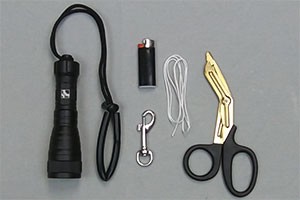 |
|---|---|---|
| 2. | Cut a length of cave line a couple of feet long. Run it through the eye of the bolt snap, then run each end of the line through the object's hole in opposite directions. (If the object is a hose, then just wrap each end around the hose.) | 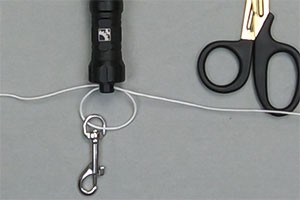 |
| 3. | Run each end of the line through the eye of the bolt snap (in opposite directions). | 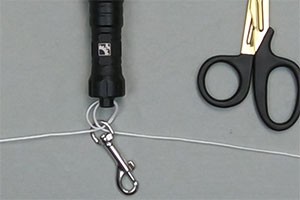 |
| 4. | Snug up the line to allow the desired distance between the bolt snap and the object. Tie an overhand knot so that it rests against the bolt snap. | 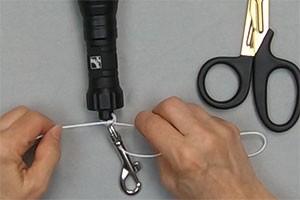 |
| 5. | Turn the whole assembly over, so you're looking at the other side. Tie an overhand knot, tight enough to encircle and snug up the lines running between the bolt snap and the object. Tie a second overhand knot (the reverse of the last one) to form a square knot. Pull it very tight. | 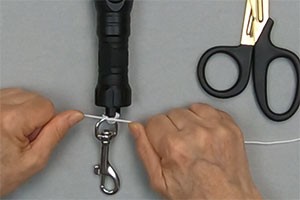 |
| 6. | Trim each end of the line, leaving about 1/4-inch free. | 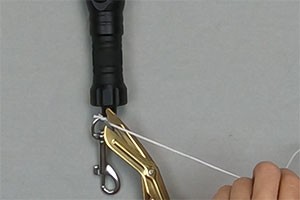 |
| 7. | Use the lighter to melt one of the free ends of the line, which will ball up into a shape roughly resembling a mushroom cap. Keep the heat of the flame away from the object. You want to melt the end of the line and nothing else. Be very careful to avoid touching the molten nylon, and don't let it drip on you. Molten nylon can cause a very painful burn! Alternately, some divers prefer to secure the tie by placing a drop of SuperGlue directly on the knot, rather than melting the ends of the line, especially if the line is polyester instead of nylon. | 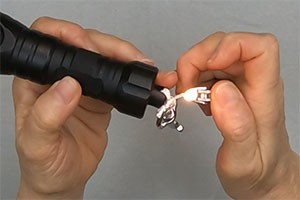 |
| 8. | Mash down the molten nylon (using the blunt end of the lighter works well), flattening it out and preventing the ends from slipping back through the knot. Blow on the molten nylon until cool. Repeat steps #7 and #8 with the other free end of the line. | 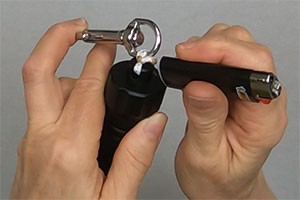 |
| 9. | Carefully examine the finished product. Twist it. Pull on it. Look for any sign of weakness, and if you find one, cut the knot off, and start over from the beginning. | 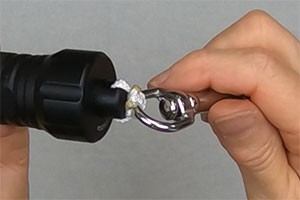 |
Attaching Breakaway SnapsIn the past, we recommended using a large o-ring for breakaway connection on snaps attached to regulators and SPGs. However, o-rings were not durable. Now we recommend our hose clip retainer as a durable alternative for quick on/off attachment of clips to regulator and SPG hoses. In the photo we are using the hose clip retainer with a slimline high-pressure hose, so we looped it twice around the hose to make it very snug. |
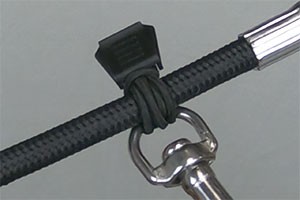 |